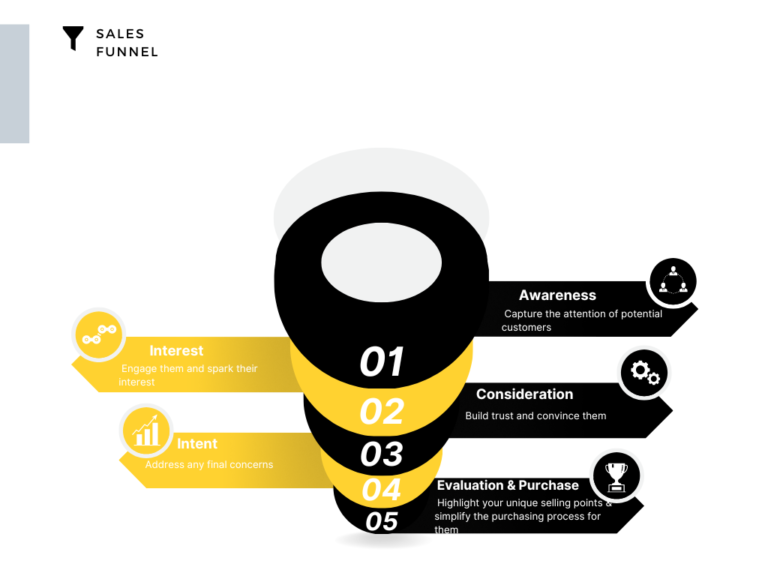In this article, we will break down each stage, and offer techniques to optimize each phase, with real-world examples to give you an understanding of how to leverage the sales funnel for your business growth.
What is a Sales Funnel
A sales funnel represents the journey a person takes from becoming aware of your product or service to making a purchase. This journey is seen as a funnel because it starts with many potential leads and narrows down to those who eventually convert into customers. The stages of a sales funnel typically include awareness, interest, consideration, Intent, evaluation, and purchase. For example, let us consider Everlane, which is an online clothing retailer known for its transparency and Farmdrop, which is an ethical online supermarket that delivers fresh groceries from local farmers to customers’ door. Both with effective and unique sales funnel.
Now, we might ask why the sales Funnel is Important. Now the sales funnel is important for several reasons for your business;
- It guides your sales process, by providing you with a clear path for your teams to follow, and ensures no leads are lost or overlooked
- It improves efficiency by allowing your sales teams to tailor their approach based on where prospects are in the funnel.
- It helps you predict sales which enables you to forecast future sales and plan accordingly.
- It enhances the prospects’ experience by addressing their needs at each stage which helps you build trust and fosters long-term relationships with them.
From Lead to Customer: Understanding the Journey
When a person first shows interest in your company’s product or service, such as visiting your website or downloading a free resource, they are considered a lead. This is the initial stage where their interaction is purely exploratory, and there’s minimal commitment.
As the relationship progresses, the lead is nurtured through targeted marketing efforts. When their interest deepens, and they start showing genuine intent by engaging more with your content, asking detailed questions, or indicating a potential purchase timeline, they transition into a prospect. This typically happens during the consideration and intent stages of the sales funnel.
Finally, with personalized follow-ups and addressing their specific needs and concerns, the prospect moves towards making a purchase decision. Once they decide to buy, they become a customer, completing their journey through the sales funnel.
How to Create a Sales Funnel
- Define Your Target Audience -Just like building a business, you need to understand who your ideal customers are and what their pain points and needs are.
- Generate Leads- Use marketing strategies such as content marketing, social media, and SEO to attract potential customers.
- Nurture Leads- Provide valuable information about your product or service and engage with leads through email marketing, webinars, and other methods.
- Convert Leads- Use personalized communication and offers to convert leads into customers.
- Retain Customers- Provide excellent customer service and follow-up to ensure customer satisfaction and loyalty.
What are the 6 Stages of the Sales Funnel?
Awareness
So, the awareness stage is the first stage of the sales funnel. In this stage, you want to capture the attention of potential customers and make them aware of your product or service. So this will involve casting a wide net to reach a broad audience and introduce them to your brand. Here, you will want to develop high-quality, educational content that resonates with your target audience. This could include blog posts, eBooks, webinars, and infographics. You will need to, ensure the content addresses common pain points and positions your brand as a thought leader. You can use tools like Ahrefs or SEMrush for keyword research to optimize your content for search engines. After, engage with users through interactive content such as polls, quizzes, and live sessions on platforms like Facebook, Instagram, or LinkedIn to reach potential customers. This way you could use Tools like Hootsuite or Buffer to help manage, schedule, and analyze your social media campaigns and content. Let’s take an example to showcase this stage in real life, let’s say a new SaaS company host a series of webinars which demonstrate how their software addresses specific industry challenges after they promote their webinars through social media and email marketing where they can attract a large audience, build brand awareness, and generate leads for their brand.
Interest
Once potential customers know your brand, the next step is to engage them and spark their interest. This will involve providing more in-depth information about your products or services and nurturing the relationship. Here, you will need to Segment the emails you got from user engagement in the awareness stage, based on user behaviour and preferences. Then Send personalized emails that provide valuable content, such as industry insights, product updates, special, ebooks, whitepapers, and case studies to the potential customers. For example, use tools like Mailchimp, SendGrid or Hubspot to help create and manage personalized email campaigns. Apart from sending personalized emails, you could also implement retargeting campaigns to re-engage visitors who have shown interest but haven’t yet considered buying your service and products. These ads will remind them of your brand and encourage them to return. For the ads, you can use Google Ads and Facebook Ads to run your retargeting campaigns. For example, An online apparel store might use retargeting ads to show visitors the products they viewed or added to their cart, where they offer a discount in the ad which will, encourage customers to return and complete their purchase. Another example is Everlane which provides detailed information about its supply chain, including where its farmers source their products.
Consideration
At this stage, prospects are evaluating whether your product or service meets their needs or not so, you would want to Build Trust and convince them. You can offer personalized product demos to Allow prospects to experience your product firsthand, webinars or case studies and highlight specific results and benefits achieved by other customers to demonstrate the value and success of your product. Tools like Zoom are ideal for hosting webinars and personalized demos. For example, Let’s say A medical software company creates case studies showcasing how their solution improved patient outcomes at various hospitals and also provides detailed results and customer testimonials this way they can build trust and credibility with prospects.
Intent
Now, at this stage, prospects are showing intent to purchase. Here, you will need to address any final concerns and encourage them to take the next step. You can provide personalized detailed pricing information, customer testimonials, and case studies to high-intent leads to address any remaining doubts to guide them through the final steps. You could also create a sense of urgency with limited-time offers and discounts to motivate them further. Use tools like Outreach or SalesLoft for personalized sales communication and follow-ups and Proposify or PandaDoc for creating and managing sales proposals.
For us to see this stage in action you can think of A real estate agency which offers virtual tours and personalized consultations for high-intent leads to allow prospects to explore properties in detail and get their specific questions answered, increasing the likelihood of closing a deal.
Evaluation/Desire
During the evaluation stage, prospects are making their final comparisons and considering the value of your product. So, this is the time to highlight your unique selling points and reassure them of their choice. You can provide detailed comparisons between your product and your competitors, highlighting your product’s unique features and benefits that set you apart.
Make sure to also encourage satisfied customers to share their experiences so you can Leverage these positive reviews and testimonials to build trust. You can use platforms like Trustpilot or G2 to collect and showcase customer reviews and Crayon or Kompyte for creating detailed product comparisons.
An example to showcase this stage is we can think of A software company that would create a sandbox environment where potential customers can test the product against competitors. By providing a risk-free trial, prospects can evaluate the software’s performance and make an informed decision which will move them to the next stage. For Farmdrop at this stage, they foster the desire of customers by their commitment to sustainability. This way, customers become drawn to the brand because they want to make ethical purchases.
Purchase
This is the final stage where prospects make their final decision to become customers, which makes it all the most so critical. Therefore, ensuring a seamless purchasing process and offering post-purchase support is vital to closing the deal and building customer loyalty. Here, you can simplify the purchasing process by offering quick and secure multiple payment options. For example, you can use platforms like Stripe or PayPal for a secure and flexible payment option then you Implement a follow-up strategy to ensure customer satisfaction by either Sending a thank-you email, requesting feedback, or providing additional resources to enhance their experience.
In this stage, you can think of a retail business that offers loyalty programs and personalized post-purchase recommendations. By providing exclusive offers, they can encourage repeat purchases and build long-term relationships.

How to Optimize the Sales Funnel for Your Business
Optimizing your sales funnel involves several strategic actions. First, determine the best channels for capturing high-quality prospects. Focus your marketing and prospecting efforts where your target audience spends their time. Use tools like Google Analytics to track where your leads are coming from. Next, track prospect behaviour using CRM software like Salesforce or HubSpot, which provides real-time insights. Establish clear criteria for each stage to identify where prospects might be stuck and why. Lastly, continually refine and adapt your strategies based on performance data and market feedback.
Conclusion
Understanding and optimizing the sales funnel is essential for guiding prospects through the customer journey and converting them into loyal customers. If you implement advanced techniques, leverage the right tools, and tailor strategies to your specific industry, your business can enhance its sales processes, and you will achieve sustained growth
Post tag :

Founder, Chief Content Officer & Web Developer
Categories
Recent Post
Subscribe
Quicklinks
Newsletter
Copyright © 2024 EVERYTHINGEMAKESS

